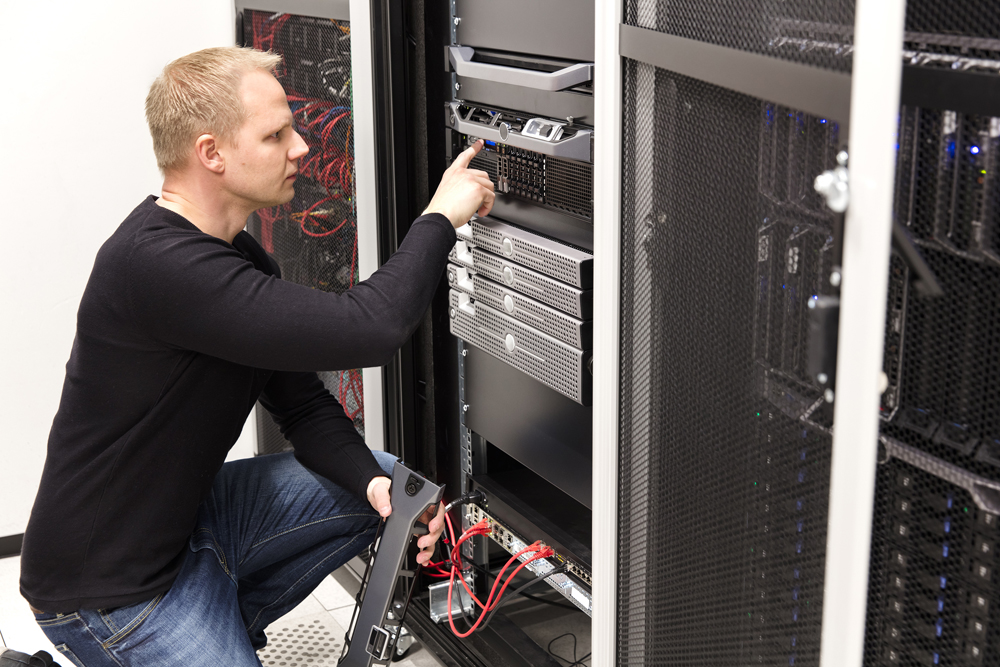Office relocations are stressful enough without adding the extra layer of complexity of organizing your IT’s data, files, applications, and hardware. Moving your IT infrastructure to a new office requires careful planning and execution. Here are some tips to help you plan, execute, and recover successfully from your next big IT move.
Sound overwhelming? It doesn’t have to be! With our IT checklist for office moves, we’ll walk you through every step of the process so that you can focus on what matters most: moving your business forward.
Table of Contents
Things To Consider When Making Your IT Office Move Checklist
Planning a successful IT migration requires careful planning. While it’s important to keep moving forward, it’s equally important to take care of the little details. Here are eight things you must do before you begin your move.
1. Know Your Network Requirements
Before packing up your current office, ensure you understand the type of connectivity required and the minimum requirements. You might consider a wireless solution if you’re relocating to a smaller space. You don’t necessarily have to go with wired solutions, either. Many companies offer mobile hotspots that allow employees to connect wirelessly from anywhere within the building. Note that your network infrastructure will affect your network connection, so clearly understanding your requirements is critical.
Network security is another consideration. Ensure your new location has adequate security measures to protect against cyber threats. This includes ensuring that all devices connected to your network are properly secured and backed up.
2. Check Your Equipment
Make sure you’ve got everything covered. Make sure you’ve got enough power outlets to accommodate your equipment needs. And remember to check your cooling systems. You don’t want your servers running hot while trying to pack up your office. Ensure you have a secure location for servers and other sensitive equipment.
3. Find Out What Kind Of Internet Service You Need
There are three main types of internet service: cable, fiber optic, and satellite. Each one offers different benefits and drawbacks. Before making your decision, find out what kind of connection you need. This will help you determine whether you need a dedicated IP address or a virtual server. A virtual server allows you to use multiple computers on a single physical device. But it does come with some limitations, such as bandwidth caps and increased costs.
If you’re looking to relocate to a new facility, you’ll likely need to bring in your equipment. However, many third-party providers can provide you with the necessary equipment if you’re uncomfortable doing this. When speaking with your Internet service provider, ensure they offer the services required in your new office location.
4. Decide Whether To Use Virtualization Or Dedicated Servers
Virtualization is becoming more popular every day. It’s a great option because it allows you to consolidate several devices into a single system. You can also scale down your resources as needed. On the other hand, dedicated servers are typically more expensive than virtualized options. They also require additional maintenance. Come up with a configuration plan that works best for your company.
If you’re going to have onsite servers, you’ll need to discuss your server room requirements with your ISP. The room size should depend on how many users you expect to have access to the servers. For example, if you only have two people accessing the servers, you may be able to get away with a small closet. However, if you have 50 people accessing the servers, you’ll probably need a larger room. You’ll also need to figure out the network cabling requirements. Do you need Cat 6? Fiber Optic? Wireless?
5. Determine How Much Bandwidth You Need
Bandwidth refers to the amount of data transferred over a given period. The higher the number, the faster the transfer rate. Most businesses tend to focus on speed when choosing their bandwidth. However, there are other factors to consider, too. For example, how much data is being transferred? Do you need high-definition video streaming? These questions should factor into your decision.
6. Consider Which Devices Will Work Best In Your New Office Space
You’ll probably need to purchase new equipment when you move to a new location. That doesn’t mean you have to buy all new hardware. There are many ways to save money by purchasing used equipment. For instance, you could look for refurbished laptops and desktops. These items often cost less than their new counterparts. Ensure you have enough power jacks for each piece of equipment. If you don’t, you’ll need to ensure you have an adequate UPS (uninterruptible power supply).
7. Business Phone Systems
Do you have a VoIP telecommunications system? If so, you’ll want to ensure you keep it working after moving to a new office space. This will allow you to continue using your existing telephone lines. You’ll need to speak with your telecom solution provider or MSP and give them plenty of time to move your phones. They are there before you arrive at the new office location.
How To Avoid Pitfalls When Moving Your Office’s IT Infrastructure
Moving your office’s IT infrastructure isn’t something most companies take lightly. There are many factors to consider, including where to locate the equipment, how long the relocation process takes, and whether or not there will be downtime during the transition. If you plan ahead, however, you’ll be able to minimize the impact on your business. Here are some tips to help you successfully move your office’s IT infrastructure:
1. Decide Where To Place Your Equipment
Before planning your move, decide where you want to place your equipment by reviewing the floor plan. This decision should include both physical and logical considerations. For example, suppose you relocate your server to a different part of the building. In that case, you’ll need to determine which network cables run through the area. You also might want to consider placing your equipment in a central location. This way, you won’t have to worry about running cables throughout your entire office.
2. Determine How Long It Takes To Relocate Your Equipment
When determining how long it will take to relocate your equipment, remember that it depends on several factors. First, you’ll need to figure out how much time is required to move the equipment from one location to another physically. Depending on the size of your office, this step could take anywhere from a few hours to a few days.
Next, you’ll need to factor in the time it takes to set up the equipment at its new location. While this step varies depending on the type of equipment you use, it typically requires between 30 minutes and two hours. Finally, you’ll need to account for any downtime caused by the move. This includes any scheduled maintenance or repairs performed while the equipment is relocated.
3. Plan Ahead
If you don’t plan ahead, you could have an expensive surprise when you arrive at your new office. That’s why it’s important to schedule all of your moves well in advance. When you do so, you can avoid unexpected costs and ensure that your equipment arrives safely and on time.
4. Consider Using Movers Who Specialize in Electronics Transit
While most businesses can handle basic moves without difficulty, some companies require more specialized services when transporting their electronic equipment. If this applies to you, you may want to consider using movers specializing in electronics transport. These professionals know exactly how to move sensitive computer equipment safely. They also understand how to secure any data stored on these devices properly.
5. Understand What You Need to Protect During Transit
You’ll need to develop a plan for protecting your business data while it’s being moved. In addition to ensuring you have enough storage space to hold your data, you’ll want to consider how you’ll migrate data to a new location. Is there a way to use cloud storage solutions to move files around? Will you need to purchase additional hardware to support your new environment? And what about backup copies? Are you backing up your data regularly, and do you have plans to continue doing so once the move is complete?
6. Inventory Your Existing Assets
Make an inventory of everything your business has, including any computers, phones (including smartphones), tablets, laptops, desktops, monitors, fax machines, copy machines, etc. You’ll want to ensure that everything you’ve got is accounted for, including software licenses and hardware configurations.

7. Make Sure Your Employees Are Prepared
It’s not uncommon for employees to forget something during a move. If this happens, you may scramble to replace it before your next business day begins. To prevent this scenario, ensure that everyone in your office knows what is expected of them for the upcoming move. This way, they’ll know what needs to be done and when.
8. Plan for Potential Network Downtime
It’s important to plan ahead for potential downtime during your move. For example, suppose you’re planning on migrating your email service to Office 365. In that case, you’ll want to ensure you have an alternative solution ready if something goes wrong. It’s not uncommon for email migration projects to encounter issues along the way. Make sure you have contingency plans in place to minimize the impact of any delays or unexpected problems.
9. Keep Track Of All Materials And Items
After you’ve moved everything into your new space, you’ll need to keep track of all the materials and items used in the process. This way, you’ll know what was lost or damaged during the move. Also, if you ever need to return anything to its original location, you’ll know exactly where to look.
VoIP and Business Continuity
The next step is to assess what you need to do regarding the continuity and disaster recovery of your telecommunications infrastructure during the move and setup process. You’ll want to ensure you’re prepared for voice and data communications throughout the transition.
For example, what are your bandwidth requirements? How much bandwidth does your existing telecom infrastructure provide? Suppose your current network doesn’t meet the capacity requirements to support your business. In that case, you might need to upgrade your existing equipment or add additional hardware to accommodate the growth of your organization.
Also, what type of connectivity do you use today? Is it based on traditional circuit switching networks like POTS or PSTN, or is it IP-based? Suppose you’re migrating to a VoIP solution. In that case, you’ll likely need to replace your old analog telephone adapters (ATAs) with digital ones.
You’ll also need to consider how many people are involved in your enterprise and where they work. For example, suppose you have several locations spread over multiple buildings. In that case, you might need to plan for each building to have a separate network. Or, if you have different types of offices within one building, you might need to ensure everyone has access to the same kind of connectivity.
In addition, you’ll want to consider what kind of redundancy you have in place for your IT environment and security requirements. Does your business rely heavily on cloud computing solutions? What happens if your servers crash? Will you lose critical applications and data? Do you have backup storage systems in place? If so, will they be accessible after the move? What if there is a security breach? Does your security policy include backup procedures? These questions will help you determine whether you need to invest in new technology, such as a virtual private server (VPS).
Finally, you’ll want to assess whether you have a backup power supply for your telecommunication systems. If your current power source fails, will you still be able to connect to your communication network?
If you don’t already have a comprehensive plan, now is the best time to start thinking about how to prepare for your upcoming relocation.
Wrapping Up
As you can see, there are plenty of reasons why you should prepare for your next office move months in advance. The planning process takes a long time because you’ll need to move your communication infrastructure, including phone equipment, computers, printers, fax machines, and other devices.
However, the benefits of preparing early outweigh the costs associated with moving day. By planning your office move properly, you’ll save money by avoiding unnecessary expenses and headaches. You’ll gain peace of mind knowing that you’ve taken all the necessary steps to ensure everything runs smoothly when you arrive at your new location.
By taking steps like those outlined above, you’ll be able to avoid costly mistakes and enjoy a smooth transition and successful office move. Click the bold blue words to download our In-Depth IT Checklist For Small Businesses To Make Your Next Office Move A Breeze.







Recent Comments